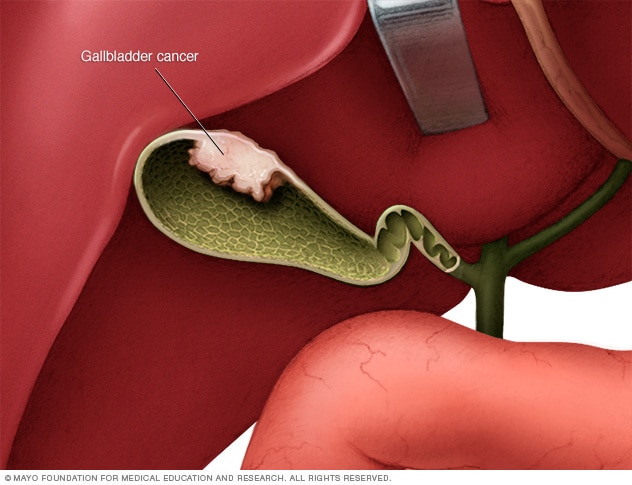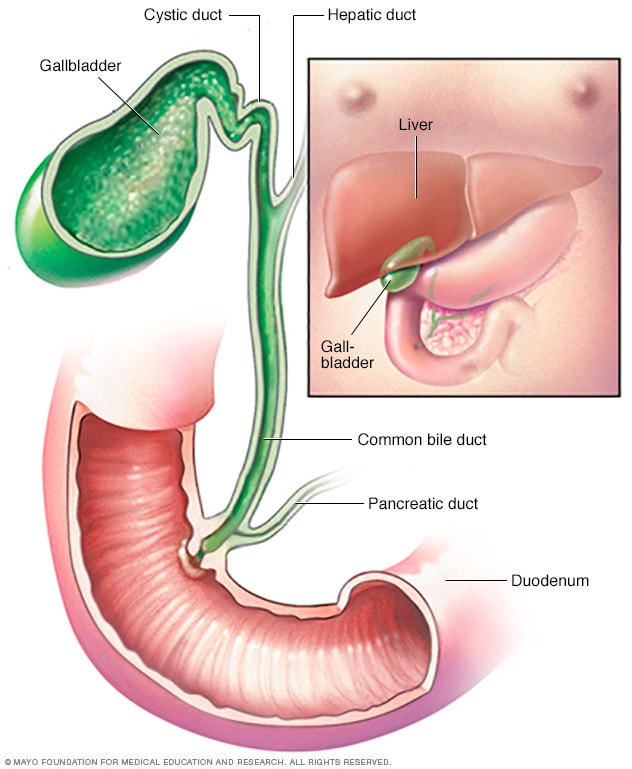Overview
Gallbladder cancer

Gallbladder cancer
Gallbladder cancer is a growth of cells that begins in the gallbladder. The gallbladder is a small, pear-shaped organ on the right side of the belly, just beneath the liver.
Gallbladder cancer is a growth of cells that begins in the gallbladder.
The gallbladder is a small, pear-shaped organ on the right side of the belly, just beneath the liver. The gallbladder stores a fluid called bile that the liver makes to digest food.
Gallbladder cancer is not common. The chance for a cure is good when gallbladder cancer is found when it's small. But most gallbladder cancers are found when they've grown beyond the gallbladder. Then the chance to survive, called prognosis, often is poor.
Gallbladder cancer may not be found until it's advanced because it may cause no symptoms. When they happen, the symptoms may be like those of common conditions. Also, the gallbladder is hidden inside the body. This makes it easier for gallbladder cancer to grow without being found.
Products & Services
Symptoms
Gallbladder cancer may have no symptoms. When there are signs and symptoms, they may include:
- Belly pain, mostly in the upper right part of the belly.
- Belly bloating.
- A mass you can feel through the skin.
- Losing weight without trying.
- Yellowing of the skin and whites of the eyes, called jaundice. Yellowing of the skin might be harder to see on Black or brown skin. Jaundice typically happens when the gallbladder cancer is very advanced.
When to see a doctor
Make an appointment with a healthcare professional if you have symptoms that worry you.
Causes
Gallbladder and bile duct

Gallbladder and bile duct
The gallbladder holds a yellow-green fluid that the liver makes, called bile. Bile flows from the liver into the gallbladder. It stays in the gallbladder until needed to help digest food. During eating, the gallbladder releases bile into the bile duct. The duct carries the bile to the upper part of the small intestine, called the duodenum, to help break down fat in food.
It's not clear what causes gallbladder cancer.
Healthcare professionals know that gallbladder cancer starts when healthy gallbladder cells develop changes in their DNA. A cell's DNA holds the instructions that tell the cell what to do. In healthy cells, the DNA gives instructions to grow and multiply at a set rate. The instructions tell the cells to die at a set time.
In cancer cells, the DNA changes give different instructions. The changes tell the cancer cells to make many more cells quickly. Cancer cells can keep living when healthy cells would die. This causes too many cells.
The cancer cells might form a mass called a tumor. The tumor can grow to invade and destroy healthy body tissue. In time, cancer cells can break away and spread to other parts of the body. When cancer spreads, it's called metastatic cancer.
Most gallbladder cancer begins in the glandular cells that line the inner surface of the gallbladder. Gallbladder cancer that begins in this type of cell is called adenocarcinoma. This term refers to the way the cancer cells appear when looked at under a microscope.
Risk factors
Factors that can increase the risk of gallbladder cancer include:
- Female sex. Gallbladder cancer is much more common in women than in men. Experts think it may be related to the hormone estrogen, which increases the risk of gallstones. People who are assigned female at birth most often have higher levels of estrogen in their bodies than do people assigned male at birth.
- Increasing age. Your risk of gallbladder cancer increases as you age. It's more common after age 65. But it can happen in children.
- A history of gallstones. Gallbladder cancer is most common in people who have gallstones or have had gallstones in the past. Larger gallstones may carry a larger risk. Gallstones are common. But even in people with gallstones, gallbladder cancer is rare.
- Other gallbladder conditions. Other gallbladder conditions that can increase the risk of gallbladder cancer include polyps, infections, and ongoing swelling and irritation, called chronic inflammation.
- Inflammation of the bile ducts. Primary sclerosing cholangitis causes inflammation of the ducts that drain bile from the gallbladder and liver. This condition increases the risk of gallbladder cancer.
Healthcare professionals have not found ways to prevent gallbladder cancer.